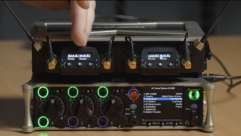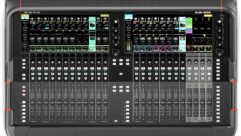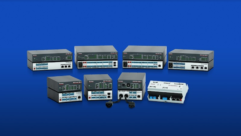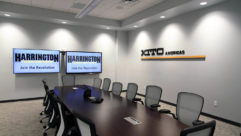
Digital Video Essentials Professional
Aug 1, 2005 12:00 PM,
By Jeff Sauer
Test patterns and footage to help calibrate any display.
If you’ve been in the AV industry very long, you’re probably familiar with Joe Kane’s Video Essentials DVD. Since its introduction eight years ago (indeed, before that with the Laser Disc-oriented version: A Video Standard), it has become a staple for home-theater enthusiasts and AV installers alike trying to get the best picture and sound out of a media room installation. An update in 2003, Digital Video Essentials, added several new testing tools and explanations of emerging digital technology. The abundance of its teaching and tutorials, though, primarily targets the home-theater enthusiast.
Joe Kane Productions’ latest release focuses more directly on the needs of professional AV installers and calibrators. Digital Video Essentials Professional Edition ($295, distributed and marketed by Extron) is a six-disc DVD set that augments the consumer version with a more complete range of test patterns and diagnostic tools, including two entire discs of high-definition test sequences and patterns. There’s a fair amount of redundancy in DVE Professional if you already own Digital Video Essentials, but if you’re making a living in the AV installation or calibration industry, DVE Professional should be in your toolbox.
WHAT’S ON THE DISCS?
DVE Professional is billed as a six-disc set, but it’s really a little bit less than that, and maybe a little bit more, too. To begin with, DVE Professional‘s Disc One is exactly the same disc as Digital Video Essentials: same menus, same content, same included color filter sheet. Disc Two is simply a PAL version of that same disc, so if you already have what is now being called the Consumer Version ($24.95) you might be a bit surprised by the near-$300 price of DVE Pro.
Similarly, Disc Three and Disc Four are NTSC and PAL versions of the component video test material, some of which was on the original Video Essentials disc and either included or not in the updated Digital Video Essentials. Unless you do a lot of calibration work in both North America and Europe, or work with a facility that does NTSC-PAL mastering or conversions, those PAL discs aren’t likely to see a lot of use.
Disc Five and Disc Six also contain identical footage and test patterns, but this time quite valuably in four different HDTV formats and two different color spaces. Disc Five includes Windows Media HD format content in 854×480p, 720×486p, 1280×720p, and 1920×1080p using color matrix of Rec. ITU-R BT.601-5. Disc Six has the same footage in 1280×720p and 1920×1080p, but using the color matrix specified by Rec. ITU-R BT.709-4. That kind of content redundancy over a variety of HD formats and color matrices is critical for testing compatibility in today’s displays, although I’d prefer 1080i test footage rather than 1080p since it is far, far more common in the real world. Naturally, to play any of the HD footage you’ll need a Windows Media-capable computer as the source.
Interestingly, the PAL-oriented Disc Four has an important link to the Joe Kane Productions website (www.videoessentials.com), where you can register your copy of DVE Professional and gain access to manuals for each of the six discs, as well as new downloadable test patterns as they become available. Indeed, those manuals are invaluable because they contain otherwise unavailable descriptions of each of the test patterns and video clips, explanations of what each test is for, and what you should be looking for in each. That omission, and the lack of explanation, is one of the major shortcomings of the original two versions. Previously, for those test patterns not discussed in the main tutorial sections, users — both consumer and professional — were left to figure out applicability. Of course, having those PDFs files available on a DVD-ROM portion of the disc(s) would be best, but it’s certainly a very common tactic for getting users to register.
CONSUMER VS. PROFESSIONAL
As many already know, Digital Video Essentials (which corresponds to Disc One) walks home-theater enthusiasts through basic, unit-front control calibration of brightness, contrast, color, tint, and sharpness. There are also some nice sample video clips, including computer animations and some impressive original HD footage of a NASA space shuttle launch. The disc also includes several more unexplained (and difficult to reach by navigation) test patterns for AV pros doing calibration.
Disc Three (NTSC) and Disc Four (PAL) actually include many of the same test patterns as Disc One and Disc Two, although they are greatly expanded and contents are grouped more efficiently by display adjustment. For example, an entire Title on grayscale tracking includes 37 different test patterns (each a Chapter). There are entire Title sections for each of 1.33 Full, Letterbox, and Anamorphic convergence, as well as Titles of motion patterns for each. There’s a nice explanation of analog-to-digital picture resolutions in the section of the manual for that Title of 21 test patterns.
The test content on HD Disc Five and Disc Six is actually very similar to that on Disc One, including the familiar intro animation and NASA sequences and many of the basic bars, ramps, and pluge/grayscale windows. It’s just now repeated in each of the various HD flavors. There’s also a very nice film sequence that smartly explores colors, depth of field and sharpness, and resolution.
I could still quibble with navigation, a commonly noted annoyance with each of the other Video Essentials versions, but that should be a lot less important to the AV pro than to consumers. Once you learn what’s here, you’ll be able to find your way to it even if it takes a couple of extra clicks.
Admittedly, four main NTSC and HD discs may seem a little less impressive than a “six-disc set,” but not if you overlook the marketing. It’s still an extremely thorough package for installation and calibration professionals. Admittedly, the $295 price for DVE Professional is a big step up from the $24.95 cost for one-sixth of it (one-quarter if you discount the PAL discs), and that will certainly trouble some potential buyers. However, that’s a dangerous way to look at it. Simple economies of scale (i.e., the much smaller potential audience for a pro rather than a consumer version) mandate a much higher price for the pro version in any family of products.
The real question is whether DVE Pro will help you do your work. The price ultimately is less than that of most of the other test equipment you need. And once you have Digital Video Essentials Professional you’re likely to use it on just about every installation and calibration job you do. From that perspective, it’s a hard tool to leave out of the box.
PRODUCT SUMMARY
Company: Joe Kane Productions via Extron www.extron.com
Product:Digital Video Essentials Professional
Pros: Support materials explain the utility of each test pattern.
Cons: No 1080i test footage
Applications: Any display installation or calibration job
SPECIFICATIONS
Discs One, Two, Three, Four These discs have been set for Region 0, meaning that they should play on any DVD player capable of playing NTSC (Disc One and Disc Three) or PAL (Disc Two and Disc Four).
Disc Five The two-high definition rates on this disc have been encoded using the SD matrix. This has been done to provide material compatible with many computer output cards that only decode YCbCr to RGB following Rec. ITU-R BT.601-5.
System requirements for Rec. ITU-R BT.601-5 color matrix accommodation at HD rates: PCI
Motherboard: Minimum 800MHz front side bus/system bus. ASUS solution supporting SATA hard drives.
System Memory (RAM): Minimum 1GB
Video: AGP Nvidia chipset FX900 minimum, 128MB RAM exactly
DVI Output: Leadtek (recommended manufacturer)
Hard Drive: 200GB minimum SATA 7500rpm
Disc Six Compatible with systems employing the HD color matrix described in Rec. ITU-R BT.709-4. There are no SD test materials on this disc as there is no common use of Rec. ITU-R BT.709-4 for encoding such material.
System requirements for Rec. ITU-R BT.709-4 color matrix transcoding of high-definition signals: PCI-E
Motherboard: ASUS P5AD2 Processor (Minimum): Intel Pentium IV 3.4GHz 1GB L2 cache
System Memory (RAM): Minimum 1GB
Video: Nvidia FX6700 chipset Hard Drive: 200GB minimum SATA 7500rpm










